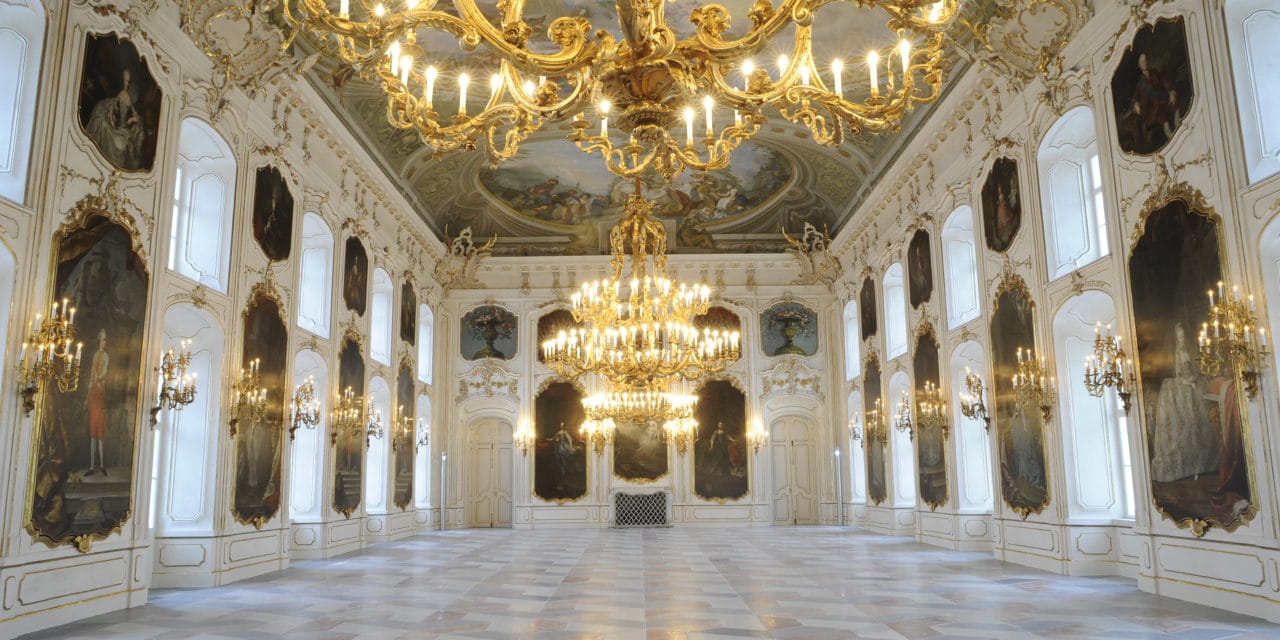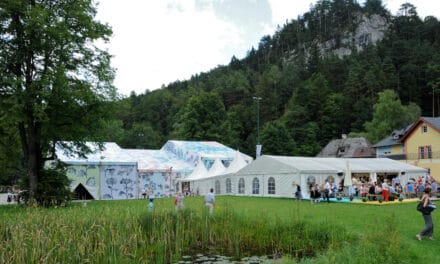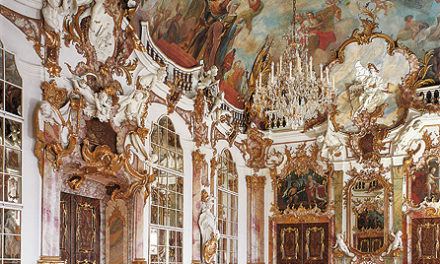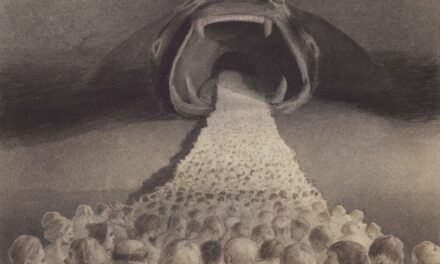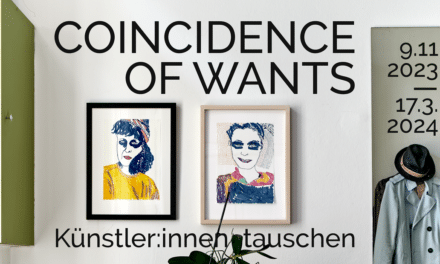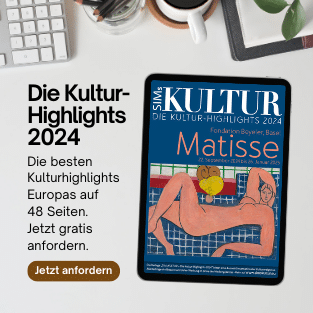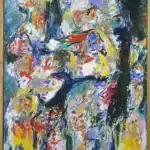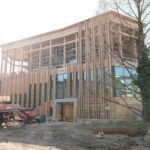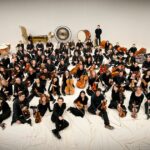The Hofburg Innsbruck was completed in 1500 under Emperor Maximilian I (1459-1519). It already had the same dimensions as today and was captured in a watercolor by Albrecht Dürer. It shows a late Gothic inner courtyard with a covered staircase, the heraldic tower and the women's chambers, known as the "Frauenzimmer". There was a large reception room, which was designed as a hall with columns and a vaulted ceiling and is now known as the "Gothic cellar". A "Kürnstube", where Maximilian's hunting trophies were kept, a "Silberkammer" (treasure chamber) and a banqueting hall (with depictions of Hercules) have also been preserved. The "Rennplatz" (racecourse) in front of the Hofburg served as a tournament ground for the sports-loving emperor.
Almost 250 years later, Maria Theresa (1717-1780) visited the Imperial Palace in Innsbruck and found it outdated. Since 1665, there were no longer any Tyrolean sovereigns and the governors, who now ruled Tyrol on behalf of the Emperor, occupied the first floor (Statthalterei). The state rooms on the second floor, which were reserved for the imperial family, remained unoccupied. The ruler ordered a renovation in the late Viennese Baroque style and sent her best artists to Innsbruck: Konstantin von Walter and Nicolaus Parcassi. Martin van Meytens and his school and Franz Anton Maulbertsch were commissioned to decorate the interior. The renovation work was interrupted by the Seven Years' War and continued into the 1970s.
Maria Theresa's decision to hold the wedding of her son Leopold (II) to Maria Ludovica of Bourbon in Innsbruck in 1765 was tantamount to a relocation, as everything from furniture to porcelain and tableware had to be organized. The wedding on August 4 was celebrated with 2000 guests (most of whom were only "spectators", however. In other words, they were not catered for). For 14 days, the guests celebrated with lavish meals, went to the opera and enjoyed themselves until August 18, 1765, when the sudden death of Emperor Franz I Stephan brought the celebrations to an abrupt end.
Maria Theresa's mourning for her beloved husband was great: after the usual Habsburg funeral ceremonies, he was laid out in the Giants' Hall and then transferred by ship to Vienna, where he was laid to rest in the Capuchin crypt. Maria Theresa had his death chamber converted into a new chapel, had the triumphal gate built with a Tauern and a wedding side and decorated with sculptures, and founded a ladies' convent where twelve noble Tyrolean women were to pray for the dead emperor for several hours a day. The latter survived all the turmoil of history and still exists today in a smaller form.
In the 19th century, Archduke Karl Ludwig (1833-1896) was governor in Innsbruck and had the so-called Inner Apartment adapted for his sister-in-law Empress Elisabeth (Sisi). Furniture in the Second Rococo style was brought to Innsbruck by the Viennese court artist August La Vigne and each room was decorated in a different color. The exquisite silk fabrics adorned the furniture and served as wall coverings and curtains. Elisabeth only stayed in Innsbruck a few times, while her husband Emperor Franz Joseph was a regular visitor to Tyrol and stayed at the Hofburg.
At the end of the monarchy (1918), the former imperial property became state property. Today, the Burghauptmannschaft manages the third most important historical building in Austria. The third and final part of the general renovation of the Hofburg was completed in 2006-10. It is frequently used for high-ranking events.
Highlights of the Hofburg
On an adventure tour through Maria Theresa's state rooms, the exclusively furnished Empress Elisabeth Apartment and the courtly furnishings from the Baroque to the 20th century. The guided tour for all generations takes you through the state rooms and apartments of the Imperial Apartments. Discover paintings of illustrious royalty, hidden corridors and curious objects from the imperial household. Surprises await around every corner.
The permanent exhibition Emperor Maximilian I
Emperor Maximilian I is one of the most famous personalities of the House of Habsburg. With a successful marriage policy, he laid the foundations for the rise of his family to become one of the most powerful dynasties in Europe. His life was marked by the fickle fortunes of war as well as the introduction of new technological achievements, which he knew how to use skillfully.
January 12, 2019 marked the 500th anniversary of his death. To mark the occasion, the Burghauptmannschaft Österreich dedicated the anniversary exhibition Maximilian I, Dawn of the Modern Era to him at the Hofburg Innsbruck from May 25 to October 12, 2019. This was also the starting signal for the new permanent exhibition, which was opened on November 22, 2019 after a short renovation phase due to the great success of the anniversary exhibition.
Using state-of-the-art multimedia technology and a digital mediation concept, the permanent exhibition not only focuses on the personality of Emperor Maximilian I (1459-1519), his wives, court life and influences that shaped his life, but also deliberately presents topics with a European or global dimension. The European expeditions to the west are covered, as are Siegmund von Herberstein's journeys to the east on imperial commission. The latest findings from research into the building history of the Hofburg Innsbruck, climate history and the contextualization of politics, religion and economics round off the exhibition content.
After the permanent exhibition was expanded in July 2020 to include the theme of Mummereien, which refers to unique costume parties at Maximilian's court, the first special exhibition Maximilian1 - The Emperor and his Tournaments was opened in May 2021. This was transferred to the permanent exhibition at the end of the year.
Guided tours in historical costumes
Audience with Maria Theresa
The empress in private - Maria Theresa's famous correspondence with Amalie Countess Enzenberg forms the basis of the dialog. It is about the preparations for the great wedding in 1765, but also about interpersonal relationships between the great ruler and her best and only friend. The tour includes two actors in historical costumes.
The Hofburg for children
Young people are introduced to the imperial world: stories are told about life in the palace, the great wedding feast, Empress Elisabeth and her flair. Recommended for children aged between 5 and 12, also suitable for school classes.
Open daily from 9 a.m. to 5 p.m.

